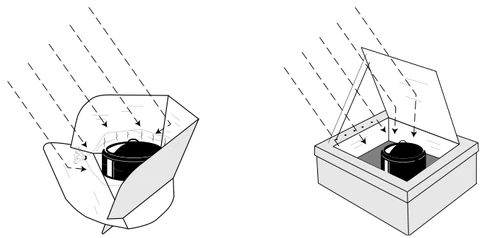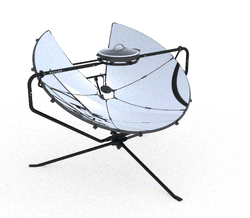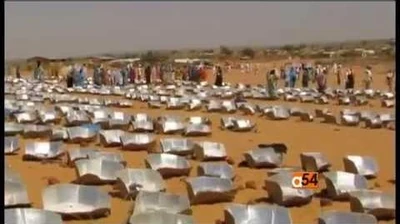|
Last edited: 30 November 2019
|
|
Below you will find an introduction to solar cooking. The Solar Cooking Wiki also provides an individual page for 143 different countries where you will find news, NGOs, manufacturers, individuals working on solar cooking projects in that country. Links to possible funders are also available: |
Depending on where you live and how you cook, solar cooking can save you time, effort, and fuel. It is also environmentally friendly, and a fun way to prepare your meals. All foods can be cooked in some type of solar cooker.
Cooking with a solar box cooker or solar panel cooker is similar to using a slow cooker (crock-pot). Cooking times for these types of cookers are typically twice that of conventional cooking methods, however, slower cooking also has its advantages. Less water is used than with conventional cooking and foods retain more flavor and nutrients rather than being steamed or boiled off. These basic solar cookers do not require the food to be stirred while cooking.
Parabolic solar cookers offer another approach to solar cooking by being able to reach higher temperatures and perform more like a traditional stovetop. As such, they require more attention while cooking to avoid burning the food and they need to be turned periodically to follow the sun depending on cooking time.
For areas in the world experiencing deforestation and limited access to clean water, solar cooking is a valuable part of the solution, by providing a safe, smoke-free alternative method of cooking and purifying water.
Buy or build a solar cooker?
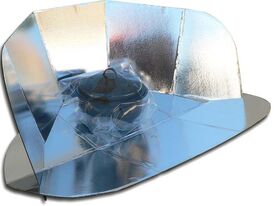
Solar Cookers International sells the CooKit solar panel cooker for $39.00 USD online here.
If you are interested in trying solar cooking for the first time, you may be wondering whether you should build your own solar cooker, or to buy one from a manufacturer. There are advantages to both options:
- Building your own solar cooker can be a fun and cost-effective way to get started.
- Purchasing a solar cooker is simple and you will often receive a higher-quality cooker than one you might build yourself.
If you would like to build a cooker, visit the build a solar cooker page to choose a design that's right for you. You will find information comparing the characteristics of each style of cooker.
If you would like to purchase a cooker, check out the list of manufacturers and vendors on the buy a solar cooker page. Commercial cookers are typically durable and efficient, and offer an easy way for new users to experience solar cooking. As cookers are manufactured globally, consider potential shipping costs when selecting a design.
How do solar cookers work?
Solar cookers work on this basic principle: Sunlight is converted to heat energy, that is retained for cooking.
Most basic solar panel cookers and solar box cookers can reach 170 °C (338 °F). The captured solar radiation passes through a greenhouse enclosure enclosing a dark colored cook pot. As it hits the dark surface, the solar radiation is converted to heat, which is unable to escape the enclosure, and cooking temperatures are achieved. The same principle is often experienced by drivers returning to a hot car that has been parked in the sun. The efficiency of these cookers is typically determined by the amount of reflector area available of the solar cooker to gather sunlight, and the ability of the greenhouse enclosure to receive the available light and help insulate the hot cook pot. Double Pyrex bowls have been shown to work well as greenhouse enclosures for solar panel cookers. See: Glazing for additional enclosure ideas.
- Parabolic solar cookers use a bowl shaped reflector to focus the light directly onto the cook pot, usually from below. Typically they do not require a greenhouse enclosure to retain the heat. They reach much higher temperatures than the other styles of solar cookers, usually above 200 °C (392 °F), and also have the ability to fry and broil foods.

SolSource is an example of a parabolic solar cooker shown with cookware. The light is focused at the bottom of the cook pot.
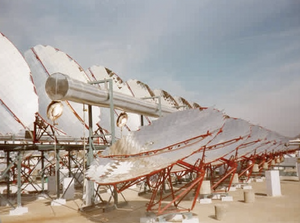
Institutional solar cooking can employ many large parabolic reflectors to generate steam, and cook for thousands of people daily. Many of these systems are in use in India. This example, was built with technology from Solare Brücke.
- Main article: How solar cookers work
Solar cooker types
The three most common types of solar cookers are box cookers, panel cookers, and parabolic cookers. Hundreds — if not thousands — of variations on these basic types exist. Evacuated tube cookers and trough cookers are two lesser known styles of cooker design. The two approaches are often combined, as the geometry of each is suited to the other. Additionally, several large scale solar cooking systems have been developed to meet the needs of worldwide.
Box cookers
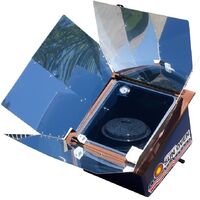
Solar box cookers typically cook food at temperatures between 90 °C (194 °F) and 200 °C (392 °F). They can often accommodate multiple pots, and usually take between one and three hours to cook various foods. The sides and bottom are insulated to retain cooking heat. Worldwide, they are the most widespread. There are several hundred thousand in India alone.
- Main article: Solar box cooker designs
Panel cookers
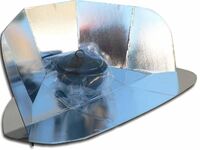
Panel cookers incorporate elements of box and parabolic cookers. They often have a large reflector area and the cook pot has some form of clear enclosure to retain heat. Panel cookers are capable of cooking at approximately 150 °C (302 °F). They are the easiest style to make and relatively inexpensive to buy.
- Main article: Solar panel cooker designs
Parabolic cookers
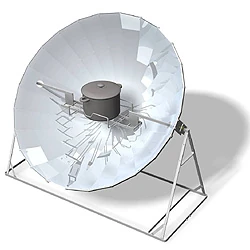
The AlSol 1.4 parabolic cooker demonstrates how the cook pot is supported to receive the focused light from below from the reflector.
Parabolic solar cookers use a bowl shaped reflector to focus the light directly onto the cook pot, usually from below, and typically do not require a greenhouse enclosure to retain the heat. The parabolic name refers to the shape of the curve of the reflector cross-section.
They require more frequent reorientation to the sun, possibly every fifteen minutes, but they cook food more quickly at higher temperatures compared to other solar cookers, often reaching temperatures over 200 °C (392 °F). They also have the ability to fry and broil foods. Generally parabolic solar cookers will need to be attended to more than box or panel cookers to avoid possibly burning the food at the bottom of the cook pot. They are especially useful for large-scale institutional solar cooking systems.
- Main article: Parabolic solar cooker designs
Trough cookers
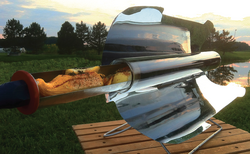
The GoSun is an example of a trough solar cooker that also uses an evacuated tube cooking chamber.
For capturing sunlight, trough solar cookers use a reflector with a curved parabolic cross-section, and then continues as a straight trough in the other direction. Instead of focusing the light at one spot like a typical bowl-shaped parabolic solar cooker, the light is reflected along what is known as a focal line. These reflectors are easier to fabricate than a parabolic dish, but require a long fairly narrow cooking tray, which is why they work well with evacuated tube enclosures.
- Main article: Trough solar cooker designs
Evacuated tube cookers
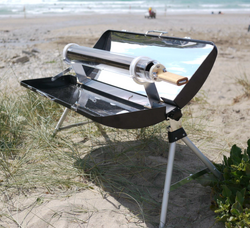
The SLiCK SM70 is an example of an evacuated tube style solar cooker.
Evacuated tube literally means that the cooking chamber is constructed of two layers of blown glass in the shape of a sealed tube, where the air has been removed between the layers.
Heat loss happens primarily by conduction and convection through a medium. With no air between the layers of glass, the chamber is nicely insulated, and well suited for retaining cooking heat. The chamber is so effective it often does not require a large reflector to capture sunlight. A slender cooking tray can be inserted from one end. The opposite end is either sealed with a stopper, or has been sealed during the manufacturing process. Improvements in glass technology is allowing for larger diameter tubes to be fabricated, which will allow larger cooking trays to be inserted inside.
- Main article: Evacuated tube solar cooker designs
Other types
- Fresnel solar cooker designs
- Solar wall oven designs
- In-the-ground solar cooker designs
- Photovoltaic cooker designs
- Hybrid solar cooker designs
- Institutional solar cooker designs
Using your solar cooker
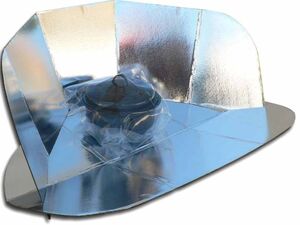
The CooKit solar panel cooker with a dark pot enclosed in a plastic bag
The golden rule for solar cooking is get your food on early, and do not worry about overcooking. Most people starting to solar cook will be using a solar panel cooker or solar box cooker. These cookers are oriented to the sun and typically don't need to be turned to follow the sun during a 2-4 hour cooking period, though cooking time can be shortened if the cooker is turned.
Once you have decided on a cooker, you will need to find appropriate cookware. Thin-walled dark enameled metal cook pots work well. They are good at heating up quickly. Glass jars can also be used, either clear or preferably painted on the outside. Please note that all cooking vessels need to have a lid. Pots that reflect light, such as silver aluminum pots, will not work. Paint these first.
Except during excellent cooking conditions, when using a solar panel cooker the pot is normally placed inside some sort of clear glass or plastic enclosure to retain heat and make use of the greenhouse effect.
- Main article: Guidelines and cooking tips
Introductory manuals
- Solar Cookers: How to Make, Use, and Enjoy (There are also detailed versions in Arabic (Standard, Variation), French, Spanish, and English for Kenya, and Galician.)
- Construction of solar cookers and driers - Christelle Souriau & David Amelin (This is an excellent overview of solar cooking basics and simple solar cooker and dryer construction methods.)

Solar orientation, Construction of solar cookers and driers, Souriau & Amelin
Learn more
- How solar cookers work
- Where is solar cooking possible?
- Interactive map of known solar cooking projects
- Why solar cooking is important
- Build a solar cooker
- Buy a solar cooker
- Solar cooking tips and tricks
- Cooking guidelines
- Recipes
- Solar cookbooks
- Health and safety
- Solar cooking frequently-asked questions
- Most significant solar cooking projects
- United Nations Sustainable Development Goals
- The history of solar cooking
- Solar cooking and emergency preparedness
- Promoting solar cooking
- Solar Cookers International White Paper - Edward Ortiz
Audio and video
- June 2015:
Star Tides 4 Solar Cookers
Our last series on the STAR-TIDES expo in Washington, DC continues with technology available for emergency crisis and disaster relief. VOA’s Carolyn Turner talked with Solar Cookers International about their exhibit displaying how to cook with only the sun - Voice of America
External links
- The Expanding World of Solar Box Cookers - Barbara Kerr (This is the full-text of the book by this solar cooking pioneer)
- Construction of solar cookers and driers - Christelle Souriau & David Amelin (This is an excellent overview of solar cooking basics and simple solar cooker and dryer construction methods.)
- Three part series by Sharon Cousins on practical, humanitarian, and environmental aspects and potential uses for solar cooking: Solar Cooking: Clean, Bright and Accessible, Out of the Smoke, Into the Sun, and Cleaner Cooking, Healthier Planet





